

IR (Infrared) Obstacle Detection Sensor Circuit. Sound via Light. Sound Transmission Using LightThese relatively simple circuits can be used to transmit information across a small distance.

The "information" I normally use is music from a radio, iPod or CD player - you could also try a microphone and amplifier. People transmit information all the time when they use remote controls for TVs, DVDs, stereo systems, etc., but they usually do not think much about the transmission as a real event. Royal Photographic Society's International Images for Science reveal the natural beauty. A Visual Representation Of The Relationship Between Science And Music. Nigel John Stanford is a musician from New Zealand who is well-known for his work in the genres of Ambient and New Age music.

In the video below, you can see a range of his musical abilities as he plays both a drum set and a piano while also rigging makeshift instruments from things like playing cards. This video is entitled 'Cymatics,' and cymatics is the science of creating visualizations of audio frequencies. On his website, Stanford explains how he became interested in visualizing sound: "In 1999 I watched a documentary on 'Synesthesia' - a disorder that effects the audio and visual functions of the brain. People with the disorder hear a sound when they see bright colors, or see a color when they hear various sounds.
Techno File: The Chemistry of Color - Ceramics Monthly. Why are Things Different Colors?
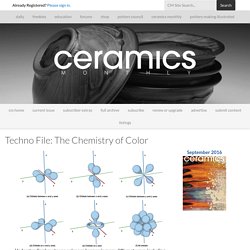
The origin of color can be understood by investigating what happens at the atomic scale. Atoms are not colored in themselves. Carbon in graphite (pencil lead) is metallic gray and in its other well-known form, diamond, it is transparent and colorless. Teaching Skills for the 21st Century: Creativity - The Art of Ed. Our job as educators is to prepare our students for life after school.
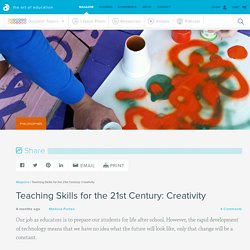
However, the rapid development of technology means that we have no idea what the future will look like, only that change will be a constant. Photo Competition, call for entries, STEAM, STEM, Photography Exhibit, Photography Competition, Cash Prize. Competition Description The National Museum of Nuclear Science & History will host a photo art exhibit that invites members of the community to share their photographic talent and eye for everything that is Science, Technology, Engineering, Art and Mathematics (STEaM).
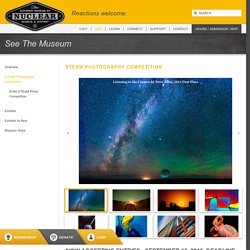
The “Atomic STEaM Photography Show” exhibition will open on November 5, 2016, and will display photography ranging from the literal engineering feats of the Great Wall of China and the Great Pyramid of Giza, to the abstract interpretation of science as seen through a plant experiencing photosynthesis. Though all photographs must relate in some way to the overall theme of science, technology, engineering, art and mathematics, they are open to interpretation by the photographer. Categories Youth Category (Individuals 17 years or younger) Open Category (Individuals, professional or amateur, 18 years or older) Gaining STEAM: Teaching Science Through Art. Breaking down the walls between art, hard sciences and math, a new crop of educators is designing curricula that allow these subjects partner with one another, encouraging holistic learning.
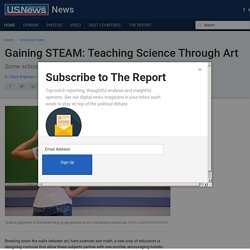
Across the country, teachers and administrators are coming to a similar conclusion: art informs science, technology, engineering and math (STEM) and vice versa. Consequently, they are pioneering new methods of teaching that combine disciplines which have been isolated from one another under traditional educational models. And they are just getting started. Andover High School in Massachusetts, for instance, teaches geometry through the lens of art. Through a scavenger hunt at a local museum, math and art students come to understand that scale in geometry is the same thing as perspective in art, says Meghan Michaud, a teacher at Andover High. This approach is “about 21st century learning skills,” Michaud says, and preparing kids “for whatever college or career is ahead.” Schopenhauer on the Essential Difference Between How Art and Science Reveal the World.
“We reach forth and strain every nerve, but we seize only a bit of the curtain that hides the infinite from us,” pioneering astronomer Maria Mitchell marveled in her diary. “Only art penetrates … the seeming realities of this world,” Saul Bellow asserted in his exhilarating Nobel Prize acceptance speech, adding: “There is another reality, the genuine one, which we lose sight of. This other reality is always sending us hints, which without art, we can’t receive.” Did Rembrandt use mirrors and optical tricks to create his paintings? Rembrandt may have traced his celebrated self-portraits from optical projections created by assemblies of mirrors or lenses, a new analysis suggests.
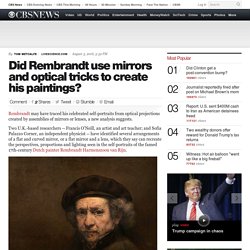
Two U.K. -based researchers -- Francis O'Neill, an artist and art teacher; and Sofia Palazzo Corner, an independent physicist -- have identified several arrangements of a flat and curved mirror, or a flat mirror and a lens, which they say can recreate the perspectives, proportions and lighting seen in the self-portraits of the famed 17th-century Dutch painter Rembrandt Harmenszoon van Rijn.
"The evidence suggests he used lenses and projections," O'Neill and Palazzo Corner wrote in a paper published online July 13 in the Journal of Optics. "The similarity of his images to projections, in their lighting and soft focus, along with the use of lens technology by his peers and fellow artists, and the contemporary literature on the subject, all support this. " [See Photos of How Rembrandt May Have Created His Self-Portraits]
Using Maths to Create Artistic Shadows. Take a look inside the world's largest cave. Girls on why they still love physics. Camera captures lightning in slow motion - video. Filipino artists get dirty to highlight pollution in Manila's rivers. Image copyright TBWA\SMP In the corner of a room in Manila, an artist dips his paintbrush into a murky mixture.

As brush strokes of brown, black and grey sweep across white canvas, the paint leaves behind rough sediments on the surface, coming out as an almost gritty texture. But this isn't any ordinary paint. The mixture is composed of water samples drawn from the most polluted rivers and tributaries of the Philippines capital. The Dirty Watercolour project aims to use art to promote awareness of environmental degradation. "What better way to raise awareness than to make use of the very medium, which is of course, water," said curator Cid Reyes.
The pigments - a range of black, grey, sepia, burnt sienna and brown - were taken from riverbed soil samples. "I was stunned when I first heard this idea," said JC Vargas, one of nine watercolour artists commissioned to paint images using these sterilised pigments. "The pigments are smelly and gritty, even when you paint with it. One man's trash. Art Talk - Quantum Physics for Artists (Or: About being wrong) Where Physics Meets Art. WASHINGTON – From some perspectives, art and physics seem to be two completely unrelated ways of seeing the world.
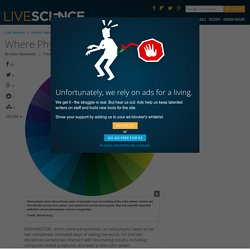
Yet the two disciplines sometimes intersect with fascinating results, including computer-coded sculptures and even a new color wheel. Jim Sanborn is an artist who creates sculptures based on science. He is perhaps best known for Kryptos, a work that stands before the entrance of the Central Intelligence Agency (CIA) headquarters in Langley, Va. The sculpture includes four sections of encrypted code messages that CIA employees and amateur cryptologists alike have devoted hours to solving; one remains a mystery. 8 Videos That Prove Math Is Awesome. Believe it or not, math is really an art.

While the subject can seem far from it when you’re caught in the doldrums of class, there’s a lot about math that’s just as creative as a Jackson Pollock and elegant as a rendition of Swan Lake. But some of us still run from those dreaded numbers, swearing up and down that it’s too complex, too rigid and just plain not fun. Lesson ideas: Ceramics - Middle School & Elementary. NAEA Instructional Resources Gallery.
Science & Art Integration Art Lessons on Pinterest. Discovering Science Through Art-Based Activities — Earth's Changing Surface. Art and science are intrinsically linked; the essence of art and science is discovery. Both artists and scientists work in a systematic but creative way — knowledge and understanding are built up through pieces of art or a series of labs. In the classroom, integrating science and visual art can provide students with the latitude to think, discover, and make connections. Located in Washington, D.C., The Lab School of Washington is a K-12 school for students with language-based learning disabilities.
In the reading, writing and math classes of the junior high school, students are grouped by their skill levels. In the science classes, the students represent many different skill levels. Art & Science Curriculum. Art & Science: A Curriculum for K–12 Teachers mines the treasures of the Getty Museum to explore the many intersections of the visual arts with scientific disciplines. The curriculum was developed by Getty educators with museum conservators, curators, and scientists and a teacher advisory group. Focusing on the science of art production and conservation and the scientific skills of investigation and experimentation, it supports student proficiency in science and visual art by exploring the fascinating territory in which the arts and sciences mingle. This online presentation contains nine out of the 36 lessons that are included in the Art & Science print publication. Sunset Lake Software. Molecules is an application for the iPhone, iPod touch, and now iPad that allows you to view three-dimensional renderings of molecules and manipulate them using your fingers.
You can rotate the molecules by moving your finger across the display, zoom in or out by using two-finger pinch gestures, or pan the molecule by moving two fingers across the screen at once. The combination of the iPhone, iPod touch, and iPad's unique multitouch input system and the built-in OpenGL ES 3-D graphics capabilities enable you to feel like you are manipulating the molecules themselves with your fingers. New molecules can be downloaded from the RCSB Protein Data Bank ( an international repository of biological molecules and their 3-D structures, or NCBI's PubChem, a public database of compounds. Molecules can be downloaded directly to your handheld device and stored there for later viewing. Custom molecule structures can also be downloaded to the device from any publicly available web server. NOVA - Official Website. Posted: April 5, 2012. Seven Brief Lessons On Physics - Carlo Rovelli. BBC Science and Islam 1 - The Language of Science. BBC Science and Islam 1 - The Language of Science.
History of Science - Islamic and Early Medieval Science - 7.2 Islamic Science. In 125 years, millions of people have looked at this painting. No one really saw it until now. I'm not easily impressed, OK? I know Van Gogh was a genius. Looking At Tears Under A Microscope Reveals A Shocking Fact. TEDxAldeburgh - Akala - Hip-Hop & Shakespeare? The genius of science: GZA & Science Genius at TEDxTeen 2014. Creativity across the arts and sciences: Richard Taylor at TEDxUOregon.
Picasso and Einstein Got the Picture - Issue 13: Symmetry. By Leonard Shlain. By Leonard Shlain. Close Looking as a Strategy for Arts Integration. Technofile: Chemistry for Potters. Art & Science Curriculum. The Enduring Relationship of Science and Art. Why Art and Science Education Go Hand-In-Hand. John M. Art advances science. The unexpected math behind Van Gogh's "Starry Night" - Natalya St. Clair. A few lesson plans exist for teaching visual arts and self-similarity (objects that have the same pattern) that could be used after showing this lesson. Shodor has some free lesson plans for students in grades 4 through 8. High school students can learn recursion algorithms to create the Koch curve using Scratch for free. Educational technologist Dylan Ryder has also written about creating fractals.
A beautiful app worth checking out is Starry Night Interactive App by media artist Petros Vrellis. International Year of Light - 100 Educational Activities about Light and Photonics. How a pinhole camera works « Pinholes. Pinholecamera. Schoolphysics. At Scotland's Crawick Multiverse Garden, You Can Look into the Void. Shaping the 21st-Century Workforce. Art & Science Journal — A publication about artworks with themes of science, nature and technology. The Solar Spark: anodising titanium- Learn Chemistry. DNA sculpture. Behind the Artwork - Norie Sato's "e+l+e+m+e+n+t+a+l" When Science Meets Art: Fabian Oefner at TEDxWarwick 2013. Fabian Oefner: Psychedelic science. Super Ultimate Graphing Challenge! Periodic table activity.
My Paintings. Vik Muniz and Tal Danino's "Colonies" How Ada Lovelace, Lord Byron’s Daughter, Became the World’s First Computer Programmer. The First Ever Photo Showing Light as Both a Particle and a Wave. 123D Circuits. Periodic Table – Royal Society of Chemistry. Chemistry of Photography - Other Topics - Articles - Chemical Engineering - Frontpage - Cheresources.com. Art and Science Intersect at School of the Art Institute Chicago - crafthaus.
About. Elements-blocks-all. Augmented Reality Chemistry Blocks. Beautiful Chemical Reactions. Do You Know the Rest of Einstein's Most Famous Equation? Art & Science Collaborations, Inc. (ASCI) - members a-k. The ArtScience Prize. When Science Meets Art: Fabian Oefner at TEDxWarwick 2013.